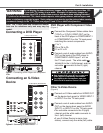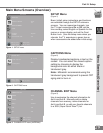
23
23
Warning: Do not leave stationary or letterbox images on the screen for
extended periods of time. Mix the types of pictures shown.
Uneven picture tube aging is NOT covered by your warranty.
The normal use of a TV should include
a mixture of TV picture types. The most
frequently used picture types should ll
the screen with constantly moving images
rather than stationary images or patterns.
Displaying the same stationary patterns over
extended period of time or displaying the
same stationary pattern frequently can leave
subtle but permanent ghost images. To avoid
this, mix your viewing pattern. Do not show
the same stationary image for more than 15%
of your total TV viewing in any given week.
Display constantly moving and changing
images that ll the screen whenever possible.
This projection TV uses picture tubes to
project the image to the screen. All picture
tubes age with use. As they age, their light
output is gradually reduced. Normal TV
pictures ll the screen with constantly
changing images. Under these conditions,
picture tubes age at an even rate across the
entire screen. This maintains a TV picture
that is evenly bright over the whole screen.
Stationary images or images that only partially
ll the screen (leaving black or colored bars
to ll the screen), when used over extended
periods of time or when viewed repeatedly,
can cause uneven aging of the phosphors and
leave subtle ghosts from the stationary images
in the picture.
Still or stationary images may be received
from broadcasters, cable channels, satellite
channels, DVD discs, video tapes, laser
discs, online services, web/Internet searching
devices, video games, and digital TV
tuner/converter boxes. Examples of these
types of images can be, but are not limited to
the following:
Letterbox top/bottom black bars:
shown at the top and bottom of the TV
screen when you watch a widescreen
(16:9) movie on a standard (4:3) TV.
Side bar images: solid bars shown on
each side of an image when watching a
standard (4:3) program on a widescreen
(16:9) TV.
Stock-market report bars: ticker running
at the bottom of the TV screen.
Shopping channel logos & pricing displays:
bright graphics that are shown constantly or
repeatedly in the same location.
Video game patterns and scoreboards
Bright station logos: moving or low-contrast
graphics are less likely to cause uneven aging
of the picture tubes.
Online (Internet) websites: or any other
stationary or repetitive computer style images.
Closed Captioning
IMPORTANT NOTES
Part ll: Installation


















